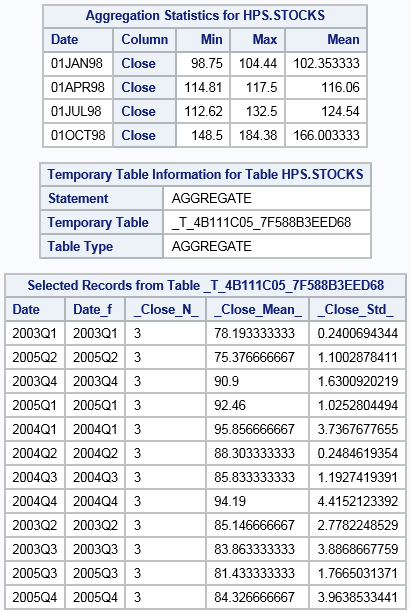IMSTAT Procedure (Analytics)
- Syntax
 Procedure SyntaxPROC IMSTAT (Analytics) StatementAGGREGATE StatementARM StatementASSESS StatementBOXPLOT StatementCLUSTER StatementCORR StatementCROSSTAB StatementDECISIONTREE StatementDISTINCT StatementFORECAST StatementFREQUENCY StatementGENMODEL StatementGLM StatementGROUPBY StatementHISTOGRAM StatementHYPERGROUP StatementKDE StatementLOGISTIC StatementMDSUMMARY StatementNEURAL StatementOPTIMIZE StatementPERCENTILE StatementRANDOMWOODS StatementREGCORR StatementSUMMARY StatementTEXTPARSE StatementTOPK StatementTRANSFORM StatementQUIT Statement
Procedure SyntaxPROC IMSTAT (Analytics) StatementAGGREGATE StatementARM StatementASSESS StatementBOXPLOT StatementCLUSTER StatementCORR StatementCROSSTAB StatementDECISIONTREE StatementDISTINCT StatementFORECAST StatementFREQUENCY StatementGENMODEL StatementGLM StatementGROUPBY StatementHISTOGRAM StatementHYPERGROUP StatementKDE StatementLOGISTIC StatementMDSUMMARY StatementNEURAL StatementOPTIMIZE StatementPERCENTILE StatementRANDOMWOODS StatementREGCORR StatementSUMMARY StatementTEXTPARSE StatementTOPK StatementTRANSFORM StatementQUIT Statement - Overview
- Using

- Examples
 Calculating Percentiles and QuartilesRetrieving Box ValuesRetrieving Box Plot Values with the NOUTLIERLIMIT= OptionRetrieving Distinct Value Counts and GroupingPerforming a Cluster AnalysisPerforming a Pairwise CorrelationCrosstabulation with Measures of Association and Chi-Square TestsTraining and Validating a Decision TreeStoring and Scoring a Decision TreePerforming a Multi-Dimensional SummaryFitting a Regression ModelForecasting and Automatic ModelingForecasting with Goal SeekingAggregating Time Series DataTraining and Validating a Neural NetworkPredicting Email Spam and Assessing the ModelTransforming Variables with Imputation and Binning
Calculating Percentiles and QuartilesRetrieving Box ValuesRetrieving Box Plot Values with the NOUTLIERLIMIT= OptionRetrieving Distinct Value Counts and GroupingPerforming a Cluster AnalysisPerforming a Pairwise CorrelationCrosstabulation with Measures of Association and Chi-Square TestsTraining and Validating a Decision TreeStoring and Scoring a Decision TreePerforming a Multi-Dimensional SummaryFitting a Regression ModelForecasting and Automatic ModelingForecasting with Goal SeekingAggregating Time Series DataTraining and Validating a Neural NetworkPredicting Email Spam and Assessing the ModelTransforming Variables with Imputation and Binning
Example 14: Aggregating Time Series Data
Details
This IMSTAT procedure
example demonstrates using AGGREGATE statement with time series data.
Program
libname example sasiola host="grid001.example.com" port=10010 tag='hps';
data example.stocks;
set sashelp.stocks;
run;
proc imstat data=example.stocks;
where stock="IBM";
aggregate close (agg=min) close (agg=max) close (agg=mean) 1
/ id=date idstart='01jan1998'd idend='31dec1998'd 2
interval="quarter"; 3
run;
where same and date >= '01jan2003'd; 4
aggregate close (agg=n) close (agg=mean) close (agg=stddev)
/ id=date idfmt="yyq6." interval="quarter" temptable; 5
table example.&_templast_;
fetch / format; 6
quit;
Program Description
-
The three aggregate expressions calculate the minimum, maximum, and mean values of the Close variable.
-
The Date variable is used to identify the time associated with each observation. The IDSTART= and IDEND= options limit the series to a single year.
-
The INTERVAL= option specifies to aggregate the observations by quarter.
-
The WHERE SAME clause is used to add a clause to the existing WHERE statement. In this case, it is used to subset the time series.
-
The second AGGREGATE statement calculates the count, mean, and standard deviation of the Close variable. The Date variable is formatted as YYQ6. and the observations are aggregated by quarter. The TEMPTABLE option saves the results of the aggregation to a temporary in-memory table.
-
The TABLE statement sets the temporary table as the active table. The FETCH statement prints the formatted values of the table.
Output
The first table shows
the results of the first AGGREGATE statement. The second table shows
the name of the temporary in-memory table that has the results of
the second AGGREGATE statement. The third table shows the contents
of the temporary table. The Date_f column shows the formatted values
of the Date column that were applied with the IDFMT= option. The other
column headings include the name of the analysis variable, Close,
and the aggregate method.

Copyright © SAS Institute Inc. All Rights Reserved.